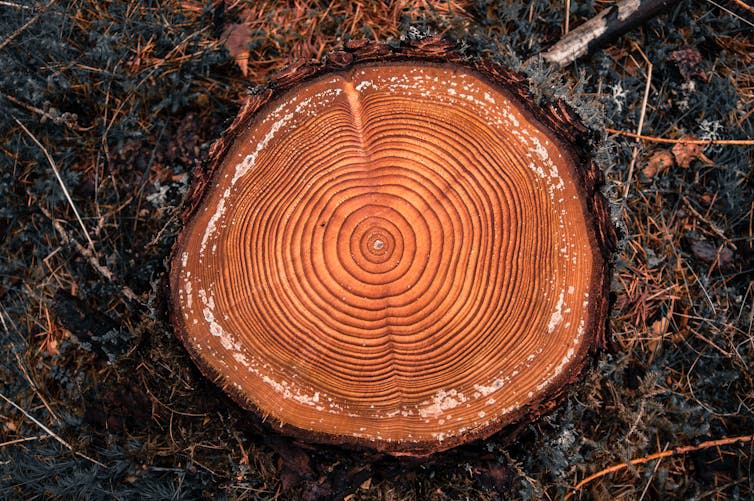The summer of 2023 was the hottest in the northern hemisphere’s non-tropical areas for 2,000 years, a new study has shown.
Across this vast land area, which includes Europe, Asia and North America, surface air temperatures were more than 2°C higher in June, July and August 2023 than the average summer temperature between AD1 and 1890, reconstructed from tree-ring records.
Although climate change is a global phenomenon, warming is often stronger on a regional scale. And it is regional climate change, not global average temperature, that humans are experiencing.
The Paris agreement aims to limit climate change to below 2°C and ideally 1.5°C of warming, but these figures refer to global temperature change, usually averaged over 20 years. The authors of the new research argue that these targets have already been exceeded on a regional scale in the northern hemisphere summer.
Five heat waves in summer 2023 in the UK caused 2,295 deaths. The authors of the new study wanted to understand how unusually warm the summer of 2023 was in the northern hemisphere compared to the past.
To do that, they turned to one of the most useful tools to take the Earth’s temperature over thousands of years: rings that grow annually in tree trunks anywhere on the planet where the climate is seasonal.
Two thousand years of tree rings
Extreme heat in 2023 was caused by greenhouse gas emissions and amplified by El Niño, the warm phase of the natural climate cycle in the Pacific Ocean.
To find out what the climate has been like in the past, scientists analyze weather station records to see if a particular year was warmer or colder than previous ones. The longest available instrumental record is the Central England Temperature series and only goes back to 1659, which is not long enough to put the recent warming into context.
To find out how hot it is now compared to two millennia ago, scientists use climate proxies. These are natural archives like ice cores and sediments that store a record of climate in the layers they accumulate over time.
Trees grow in many different places and sensitively record past climate information in much of the world. Trees grow one ring per year in seasonal climates, so there is no doubt about the date a particular ring was formed.
To study the climate of the past, tree ring scientists analyze how wide or narrow a ring is in a given year, how dense the wood is or its chemical composition.

Tree ring growth is sensitive to many climate variables, but in conifers growing at the tree limits of the northern hemisphere (the point where trees can no longer grow due to cold temperatures, high winds or low humidity) summer temperatures are a tree rules the most. ring growth. In a hot summer, such trees will tend to produce wide, dense rings.
A period in which trees from a certain region grew wide rings, or narrow rings, if accurately cross-referenced with many trees, indicates an unusual phase in the climate that affected the growth of trees.
The authors of the new study were looking for trees that faithfully recorded the previous summer’s temperature. They combined records from thousands of these trees across hundreds of sites in North America and Canada, the UK and Europe, Scandinavia, Russia, Mongolia and Japan. Scientists have provided the tree ring records by working hard to take tree core samples, measure the rings and share the data.
This massive tree-ring archive showed that the northern hemisphere summer of 2023 was warmer than the average of all years between AD1 and 1890 by 2.2°C. When compared to the coldest year of the last two millennia, AD536, when the planet’s major volcano erupted and cooled for several years, the summer of 2023 was found to be almost 4°C warmer than that year .
What will forests show in the future?
As greenhouse gas emissions rise, adding to the Earth’s greenhouse effect, people can expect more frequent and severe climate events. In the past, very warm years have occurred around the world during El Niño events, for example in 2016.
However, greenhouse gas levels are now so high that for the first time in 2017, the planet had a very warm year during the opposite of El Niño, the La Niña phase, which has a cooling effect on global temperatures.
The new study found that 2023 even broke the 2016 record because it was 0.23 ° C warmer than the last El Niño-enhanced summer. Greenhouse gas emissions are now so high that when climate records are broken, they are broken by big changes rather than small increments.
The thousands of trees sampled for this study, from mountain forests around the northern hemisphere, are facing increasingly difficult growing conditions. If the scientists were to visit them again, they would find, in many places, trees that were stressed by heat and drought.
A single drought between 2012 and 2016 in California killed more than 200 million trees. Tree deaths in France have increased by more than 80% in the last decade, a pattern seen around the world as a result of warmer droughts.
80% of biodiversity lives on land in forests and they support the livelihoods of 1.6 billion people. Trees also regulate the global climate and store carbon from the air, while slowly creating a record in their rings of our failure to stop dangerous climate change.
The extreme heat of 2023 shows the need for urgent climate action. If the world is rapidly decarbonized, future scientists hope that climate recovery will be quietly recorded in the tree records of the world’s remaining forests.


Don’t have the time to read about climate change as much as you’d like?
Get weekly salvation in your inbox instead. Every Wednesday, The Conversation’s environmental editor writes Imagine, a short email that goes a little deeper into one climate issue. Get in touch with the 30,000+ readers who have subscribed so far.
This article from The Conversation is republished under a Creative Commons license. Read the original article.


Mary Gagen does not work for, consult with, own shares in, or receive funding from any company or organization that would benefit from this article, and She has disclosed no relevant affiliations beyond her academic appointment.